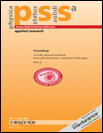Macropore formation on p-type multicrystalline silicon and solar cells
Abstract
Conditions of macropore formation on multicrystalline medium doped silicon were deduced from a systematic study of the macroporous morphology of (100) and (111) oriented monocrystalline silicon in function of the porous etching parameters and silicon doping. A new promising method to texturize the surface of multicrystalline silicon wafers has been developed which leads to a macroporous surface with a very low effective reflectivity ∼9%. Macroporous multicrystalline silicon solar cells exhibit high efficiency larger than 13.5%.




